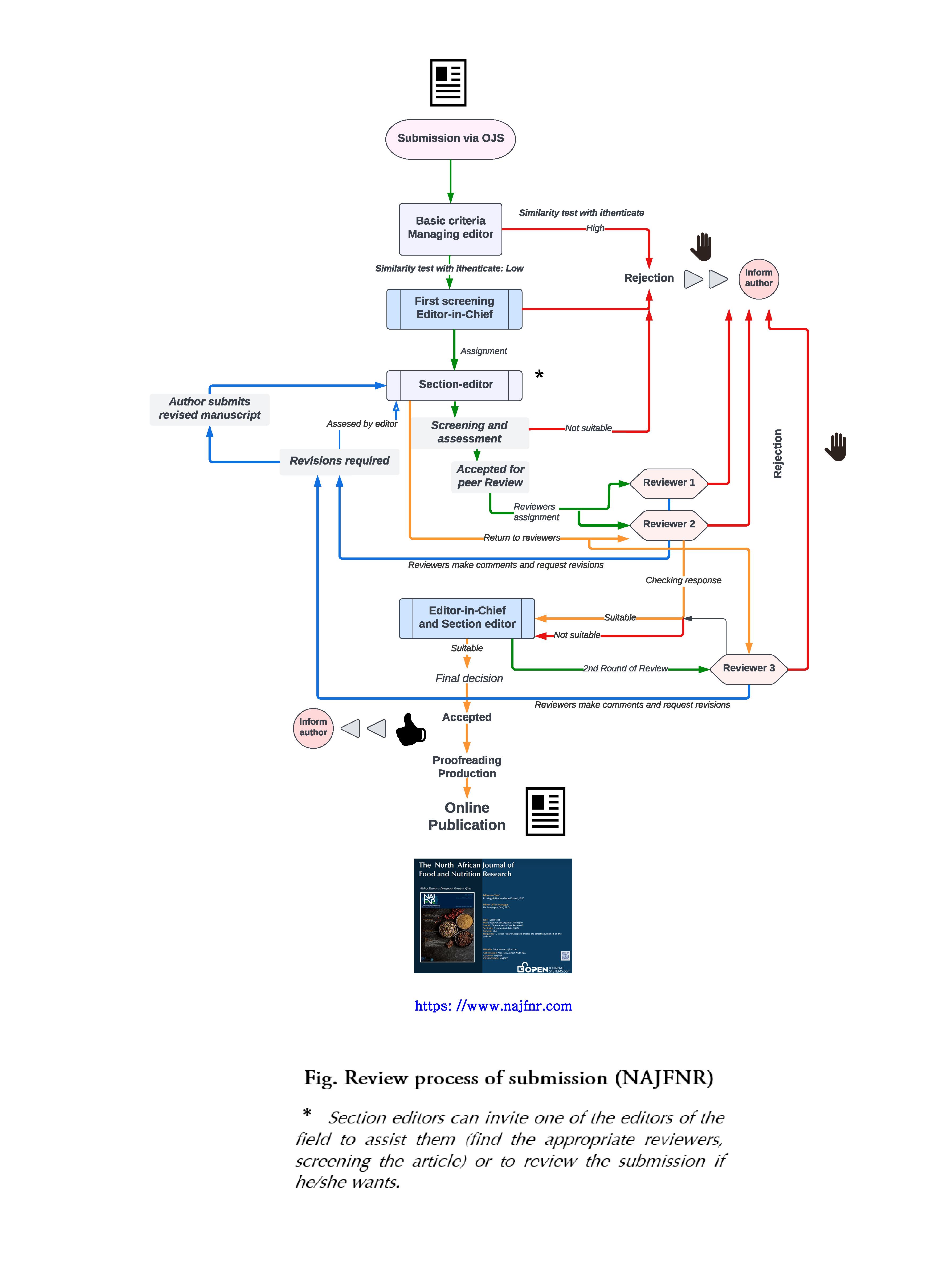Review Process


Peer review is performed to ensure that the North African Journal of Food and Nutrition Research publishes good science which is of benefit to entire scientific community.
Revisions and improvement provided by our reviewers and our proofreading assistants are part of the publication process and actually help raise the quality of submitted/accepted manuscripts.
NAJFNR's Peer Review
There are several kinds of peer review utilized by journals, although the basis is always the same.
Concerning our journal, the peer review process is performed in Double blind – in this case neither authors nor reviewers know each other’s identities. However, once the article is accepted, the names or review editors will be displayed on the final published version (first page).
Once a manuscript is submitted to our journal, it goes through an initial screening process which involves a preliminary review by the journal editor or the editorial board. At this stage, the editor has to choose any one of the following outcomes for the paper:
1. Return without review: If the editor states that the paper does not match the scope of the NAJFNR or does not meet the basic standards or expectations the paper is returned to the corresponding author after initial screening without sending it for peer review. A paper could also be rejected at this stage if it has too many grammar and syntax errors or written in another language other than English; this is something that authors for whom English is a second language need to be careful about.
2. Send the manuscript for peer review: If, after the initial screening, the editor considers that the paper matches the scope and meets the basic requirements of the journal, the manuscript will be sent for peer review. Copies of the paper are usually sent out to two to three peer reviewers. Corresponding authors is contacted and informed by email by providing a link to track submissions.
Manuscripts that are sent out for peer review receive comments and recommendations from the peer reviewers. Based on these reviews, the editor in chief takes a final decision on the manuscript. While reviewer inputs are extremely valuable for the editor, they are just recommendations, not final decisions. The final decision on the manuscript rests with the editor. So there may be instances when the editor (1) accepts a paper if (s)he is convinced about the credibility of a paper even if it has received negative comments from all the reviewers, or (2) rejects a paper if (s)he finds it unworthy of publication even if the reviewers have given positive feedback.
Publication Timeline:
- Median Time from Manuscript Submission to First Editorial Decision: 30 days
- Average Time from Manuscript Submission to Final Editorial Decision: 14 weeks
- Average Time from Manuscript Acceptance to Online Publication: 20 days
Fast-Track Publication
For authors seeking expedited publication, an optional fast-track service is available for an additional USD 50, bringing the total APC to USD 200 (exclusive of VAT). (https://najfnr.com/home/article_processing_charges)
In parallel with these operational adjustments, we remain dedicated to providing an efficient and timely publication process. Our typical publication timeline is as follows:
- Median Time from Manuscript Submission to First Editorial Decision: 20 days
- Average Time from Manuscript Submission to Final Editorial Decision: 10 weeks
- Average Time from Manuscript Acceptance to Online Publication: 15 days
More information
Please visit journal insights and metrucs for more details (https://najfnr.com/home/journal-insight-and-metrics)
For further guidance on writing a critical review, please refer to the following documents:
COPE Ethical Guidelines for Peer Reviewers. Committee on Publication Ethics. Available online.
An editor makes one of the following decisions for a peer–reviewed manuscript:
-
A. Accept in its present form: This means that the journal will publish the paper in its original form, and no changes are required. It is extremely unusual for a paper to receive this decision.
-
B. Accept with minor revisions: Also known as conditional acceptance, this decision means that the paper requires minor changes for it to be accepted. Instances of this decision are also rather rare. When a paper receives a minor revision decision, it might not be sent for a second round of peer review; usually, the editor goes through the revisions and gives a final approval. However, it is good to remember that an ‘accept with minor revisions’ decision does not guarantee acceptance. The paper will be accepted only if the editor is satisfied with the changes made.
-
C. Accept with major revisions: An editor arrives at this decision when a manuscript needs to be substantially improved before it can be accepted. The author has to submit the revised manuscript along with a point-by-point response to the reviewer comments. The revised manuscript is likely to be sent for a second round of peer review. Usually, the paper is sent to the same set of reviewers who had reviewed it the first time, but the editor may choose to send it to a different set of reviewers. The results of the second review or “rereview,” as is it referred to by some journals, are based on how well the author has addressed the reviewer and editor comments. In case the author is unable to address all the comments in a satisfactory manner, further revisions may be required, or, in the worst case, the paper might be rejected.
-
D. Revise and resubmit: Sometimes a manuscript may receive a rejection, but the editor might show willingness to consider the manuscript if it is revised and resubmitted as a new submission. If the author wishes to proceed with this, s(he) needs to revise the paper substantially based on the reviewer and editor comments, and submit it to the same journal as a new submission. This submission needs to be accompanied by a letter that states the original submission id and explains how the reviewers' comments have been addressed. The editor will review the revised paper and the letter and send the paper for a new round of peer review if required.
-
E. Reject: This is an outright rejection decision, and in most cases, the journal will not publish the paper or reconsider it even if the author makes major revisions.
Common Reasons for Rejection
Your manuscript could be rejected for many reasons (technical or editorial)
a. Technical reasons: usually include:
-
Incomplete data such as too small a sample size or missing or poor controls;
-
Poor analysis such as using inappropriate or lack statistical tests;
-
Inappropriate methodology for answering your hypothesis or using old methodology;
-
Weak research motive where hypothesis is ambiguous or not scientifically valid, or your data does not answer the question posed;
-
Inaccurate conclusions on assumptions that are not supported by your data.
b. Editorial reasons for rejection include:
-
Out of scope for our journal;
-
Not enough impact for the journal;
-
Plagiarism and violation of publication ethics;
-
Research ethics not considered such as patients' consent or approval from an ethics committee for animal research;
-
Lack of proper structure or not following journal formatting requirements;
-
Lack of the necessary detail for readers to fully understand and repeat the authors’ analysis and experiments;
-
Lack of up-to-date references or references containing a high proportion of self-citations;
-
Has poor language quality such that it cannot be understood by readers;
-
Difficult to follow logic or poorly presented data.
Manuscript Revision
Once your manuscript has come back from reviewers you may be given the opportunity to revise it according to the reviewer comments. You will usually receive a letter from the editor outlining the changes they would like you to make and links to the reviewer reports. This letter usually contains information on how to return your revised manuscript including instructions on how to highlight the changes made and when you need to return the revised version.
After revising your manuscript and responding to peer review comments you must:
-
Thank the reviewers and editors for their time and comments;
-
Address all points raised by the editor and reviewers;
-
Describe the major revisions to your manuscript in your response letter followed by point-by-point responses to the comments raised;
-
Perform any additional experiments or analyses the reviewers recommend (unless you feel that they would not make your paper better; if so, please provide sufficient explanation as to why you believe this to be the case in your response letter).
-
Provide a polite and scientific rebuttal to any points or comments you disagree with. Remember if your manuscript is sent for a second round of peer review the reviewers will see this letter too.
-
Differentiate between reviewer comments and your responses in your letter.
-
Clearly show the major revisions in the text, either with a different color text, by highlighting the changes, or with Microsoft Word’s Track Changes feature. This is in addition to describing the changes in your point by point cover letter.
-
Return the revised manuscript and response letter within the given time period.
Manuscript Rejection
Appeals of a rejection decision are only successful when you can provide strong evidence or new data that can respond to and alleviate the concerns of the editor and reviewers.
As appeals are matters of journal policy they are given lower priority than new submissions and may take at least several weeks, if not longer, to resolve.
Appeals must be rational arguments not emotional ones so be sure you have enough evidence before trying to change the editor’s mind.
If you do decide to go ahead with an appeal letter you should:
-
Clearly explain why you disagree with the decision and provide any new information that you would like the editors to take into consideration. This should not be a repetition of what you have included in your original submission or cover letter.
-
Include a point-by-point response to any reviewer comments.
-
Provide any evidence to support your opinion when you believe a reviewer has made technical errors in their assessment of your manuscript or has been biased.
NB. There may be cases when you want to submit to another journal prior to receiving a decision from our editorial office. For example if the review process is taking much longer than normal, and the editors cannot speed up the process. In this case, it is important to notify the editor that you are withdrawing your manuscript, and get confirmation that this it has been withdrawn, before you submit it to a different journal.
Manuscript Acceptance
- Authors will be notified on the acceptance of the article.
- Dates of receipt, revision and approval will be indicated in each published article.
- The Editorial Board, attending the external reports, will be in charge of making the decision on whether to reject or accept each article.
- Names or Review editors are displayed on the published article.

